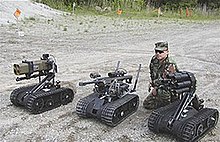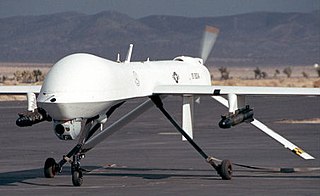
Military robots are autonomous robots or remote-controlled mobile robots designed for military applications, from transport to search & rescue and attack.

A combat engineer is a type of soldier who performs military engineering tasks in support of land forces combat operations. Combat engineers perform a variety of military engineering, tunnel and mine warfare tasks, as well as construction and demolition duties in and out of combat zones.

The Stryker is a family of eight-wheeled armored fighting vehicles derived from the Canadian LAV III. Stryker vehicles are produced by General Dynamics Land Systems-Canada (GDLS-C) for the United States Army in a plant in London, Ontario. It has four-wheel drive (8×4) and can be switched to all-wheel drive (8×8).
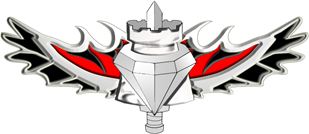
Yahalom is a sayeret unit of the Israeli Combat Engineering Corps of the Israel Defense Forces (IDF).

The Israeli Combat Engineering Corps is the combat engineering forces of the Israel Defense Forces.

An unmanned ground vehicle (UGV) is a vehicle that operates while in contact with the ground and without an onboard human presence. UGVs can be used for many applications where it may be inconvenient, dangerous, or impossible to have a human operator present. Generally, the vehicle will have a set of sensors to observe the environment, and will either autonomously make decisions about its behavior or pass the information to a human operator at a different location who will control the vehicle through teleoperation.

United States Navy Explosive Ordnance Disposal technicians render safe all types of ordnance, including improvised, chemical, biological, and nuclear. They perform land and underwater location, identification, render-safe, and recovery of foreign and domestic ordnance. They conduct demolition of hazardous munitions, pyrotechnics, and retrograde explosives using detonation and burning techniques. They forward deploy and fully integrate with the various Combatant Commanders, Special Operations Forces (SOF), and various warfare units within the Navy, Marine Corps, Air Force and Army. They are also called upon to support military and civilian law enforcement agencies, as well as the Secret Service.

PackBot is a series of military robots by Endeavor Robotics, an international robotics company founded in 2016, created from iRobot, that previously produced military robots since 1990. More than 2000 were used in Iraq and Afghanistan. They were also used to aid searching through the debris of the World Trade Center after 9/11 in 2001. Another instance of the PackBot technology being implemented was to the damaged Fukushima nuclear plant after the 2011 Tōhoku earthquake and tsunami where they were the first to assess the site. As of November 2014, the U.S. Army is refurbishing 224 iRobot 510 robots. The PackBot technology is also used in collaboration with NASA for their rovers and probes.

The Cougar is a mine-resistant ambush-protected (MRAP) and infantry mobility vehicle structured to be resistant to landmines and improvised munitions.

The Zeus-HLONS, also known as HMMWV, Laser Ordnance Neutralization System, is a solid-state laser weapon which is used by the U.S. military in order to neutralize surface land mines and unexploded ordnance. The Zeus-HLONS system was a co-operative effort between SPARTA, Inc. and Naval EOD Technology Division to demonstrate that a moderate-power commercial solid state laser (SSL) and beam control system could be integrated onto a Humvee and used to clear surface mines, improvised explosive devices (IEDs), or unexploded ordnance from supply routes and minefields.
Foster-Miller, Inc., a wholly owned subsidiary of Qinetiq, is an American-based military robotics manufacturer. Its two best-known products are its TALON robots and its LAST Armor.

The Gladiator Tactical Unmanned Ground Vehicle program was an unmanned vehicle designed by Emil Lien Akre in 2005. It was developed to support the United States Marine Corps conduct of Ship To Object Maneuver (STOM) missions through the use of a medium-sized, robotic system to minimize risks and eliminate threats to Marines during conflict. Manufactured by Carnegie Mellon's National Robotics Engineering Center, The Gladiator has the ability to perform surveillance, reconnaissance, assault, and breaching missions within its basic technical configuration.

The 20th CBRNE Command is the United States Army headquarters for defense against Chemical, Biological, Radiological, Nuclear, and high-yield Explosives (CBRNE), headquartered on the site of the defunct Edgewood Arsenal chemical weapons production facility at Aberdeen Proving Ground in northern Maryland.

Task Force ODIN, whose name is an acronym for observe, detect, identify, and neutralize, is a United States Army aviation battalion created in August 2006 to conduct reconnaissance, surveillance and target acquisition (RSTA) operations to combat insurgent operators of improvised explosive devices in Iraq.
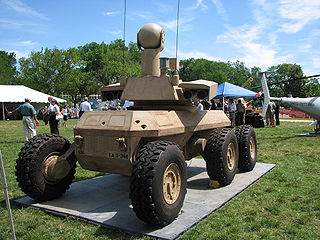
The XM1219 Armed Robotic Vehicle was an unmanned ground combat vehicle based on the MULE Platform. The ARV-A-L MULE Vehicle (XM1219) would feature integrated anti-tank and anti-personnel and reconnaissance, surveillance, and target acquisition (RSTA) systems remotely operated by network linked soldiers. The Armed robotic vehicle was canceled in July 2011 over mobility concerns.
The Modular Advanced Armed Robotic System (MAARS) is a robot that is being developed by Qinetiq. A member of the TALON family, it will be the successor to the armed SWORDS robot. It has a different, larger chassis than the SWORDS robot, so has little physically in common with the SWORDS and TALON

Counter-IED equipment are created primarily for military and law enforcement. They are used for standoff detection of explosives and explosive precursor components and defeating the Improvised Explosive Devices (IEDs) devices themselves as part of a broader counter-terrorism, counter-insurgency, or law enforcement effort.

Unmanned systems of the British Army is a list of all modern and in service remote and unmanned surveillance, reconnaissance, bomb disposal and combat systems of the British Army, as of May 2023.
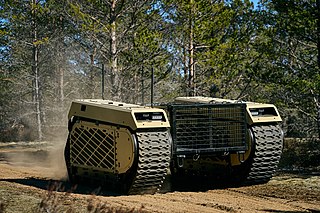
THeMIS, unmanned ground vehicle (UGV), is a ground-based armed drone vehicle designed largely for military applications, and is built by Milrem Robotics in Estonia. The vehicle is intended to provide support for dismounted troops by serving as a transport platform, remote weapon station, IED detection and disposal unit etc.


